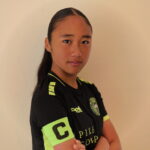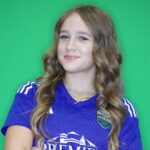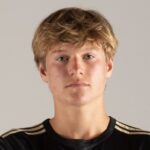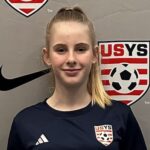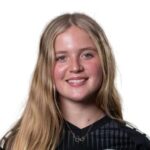SoccerWire Q&A: New York Red Bulls Academy Regional Manager Steve Jones
WASHINGTON — One club from Major League Soccer (MLS) keen on outreach and working in their local community are the New York Red Bulls, whose coaching programs work in a large area that spreads far beyond their home stadium in Harrison, N.J.
 At the Urban Soccer Symposium in downtown Washington, D.C., last week, the Red Bulls coaches had the chance to showcase some of the drills and give a flavor of their curriculum to coaches from across the country.
At the Urban Soccer Symposium in downtown Washington, D.C., last week, the Red Bulls coaches had the chance to showcase some of the drills and give a flavor of their curriculum to coaches from across the country.
The Red Bulls Soccer Academy advocate futbolinho, their own version of futsal designed to focus on players’ individual skills in a fun and interesting way.
The team have a strong outreach program, with their Urban Soccer Program helping underprivileged children across the area learn soccer skills. Working alongside organizations like the New York City Department of Parks and Recreation and the Randall’s Island Park Alliance, the Red Bulls are able to serve hundreds of children in free camps that are not only enjoyable but also safe.
[ +READ: At Urban Soccer Symposium, Dr. Ruby Payne urges closer ties between coaches, parents ]
After their demonstration at the Urban Soccer Symposium, SoccerWire.com sat down with Steve Jones, Training Programs Regional Manager for Northern Jersey and Manhattan at the Red Bulls Academy. Jones discussed their outreach programs, soccer in New York and what the future may hold for the sport in the city with the growth of the New York Cosmos and the founding of New York City FC.
SoccerWire: What’s your background and how long have you been involved with New York Red Bulls?
Steve Jones: I was born in the northeast of England, in County Durham. My family were in the air force so I got the travelling bug a long time ago. I played soccer until I found basketball, fell in love with basketball, got injured then went back to soccer. I was reasonably good at maths, physics and chemistry but found that too boring and decided I wanted to go into sports. The rest is history.
From a local college, I gained my qualifications with the Football Association, came over to America for a three-month period in 2000 and then as soon as that was complete I went back to do a coaching science degree at Liverpool John Moores University. I always said that once I’d completed that I’d come straight back out and since then, 2003, I’ve been in the country. I’ve been with the Red Bulls eight years now, with the training programs and heading the North Jersey and Manhattan region for around six of those years.
SW: How long have the programs been around?
SJ: The training programs themselves have been around since around about 2007, 2008. We’ve evolved to where we are now since that period and have increased our influence and what we provide to not just the local community but the soccer community over the past couple of years with the videos, the online information, the curriculum and so on.
[ +READ: Red Bulls look to “bridge the gap” between youth, pro levels via USL PRO]
SW: It’s something that’s really important to the franchise as a whole, you get a lot of support from the top levels?
SJ: Very much so. With anything Red Bull, we strive to be the leader, and one of the things for us is being at the forefront of player education and coach education as well as promoting the game. It is a global game, we’ve had interest from China to go over and work with a club over there to run the skills challenge, we do roadshows, we do camps. People see the need to have the event and the skills challenge and the things that are going to be helpful in engaging the players to develop them.
SW: The New York area is a very saturated sports market. Have you found that soccer is well-received by kids and their parents?
SJ: Yes, I think it’s certainly a generational thing. Everybody that remembers the New York Cosmos and the previous teams, they’re now aging out and there are youngsters that went through school and played soccer, basketball and all the major sports in America. The difference between soccer and those other sports is that soccer is very inclusive. Anyone can play, anyone can play any position, there is very much the free play mentality.
With that influence of immigrants and the diversity of that area, a lot of the European immigrants have all played soccer growing up, so they bring it over, the kids play it. Everybody that I knew 10 years ago, their kids are now playing it, so it really is a generational thing where it evolves from one generation to the next. It’s one of those sports that’s very inclusive. Anyone can play, and you can play anywhere, even downstairs in a 6×6 area.
SW: When it comes to doing outreach in the inner city, what are the major challenges that you face?
SJ: With our region alone, especially with the New York City area, it’s really space. We work with Randall’s Island because they have over 80 sports fields, they’re the main focal point for a lot of sports in the New York metropolitan area because they’re central to all the five boroughs. We work with other organizations like the Westside Soccer League, a soccer club that has 400 or 500 participants and train on one field in the spring and two in the fall.
It’s those sort of issues, that we all face, not just for the Urban Soccer Program but also the local clubs and the local organizations. It really is space, land is certainly at a premium, and if you haven’t got the money to do it and haven’t got the right partners like Randall’s Island or New York City Parks and Recreation, if you’re not working with the right partners, it’s never going to succeed.
[ +READ: Urban Soccer Symposium concludes with emphasis on life lessons from sport ]
SW: The partnership with New York City Parks and Recreation has been a particularly useful one? How did it come about?
SJ: Again, it’s an evolution. We started with one or two clinics about three or four years ago. We were approached through our connection with Westside Soccer League, a number of the people on the Randall’s Island board have connections through different people and they approached us to run a soccer camp. They run various initiatives with different sports. We’re obviously the MLS team in the local area, they approached us and we found it was a harmonious relationship and now with the backing of Sunil Gulati and Randall’s Island and Westside Soccer League, we’ve managed to evolve it where there are 125 players.
SW: You touched briefly on being the only MLS side in the city. With New York City FC coming in and the New York Cosmos growing, how do you adapt to that and what do you foresee when it comes to that competition?
SJ: I don’t foresee many changes from what we do. We’re very good at what we do and we’ve spent a long time working on it. We have the ability to evolve and adapt. I think, like with a game of soccer, competition is very good. It breeds excellence, so we now have to be on top of our game, they have to be on top of their game. They have a number of different partnerships with clubs, we have over 120 clubs we deal with in the Tri-State area, I think they have eight affiliates. Essentially, it is what it is in terms of the competition level, but again we’re all here to provide a banner model for MLS and the rivalry is a good thing for the game and for the player development side as well.


